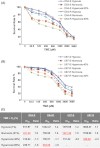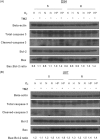Hyperoxia resensitizes chemoresistant human glioblastoma cells to temozolomide
- PMID: 22763762
- PMCID: PMC3434886
- DOI: 10.1007/s11060-012-0923-3
Hyperoxia resensitizes chemoresistant human glioblastoma cells to temozolomide
Abstract
Temozolomide (TMZ) is standard chemotherapy for glioblastoma multiforme (GBM). Intratumoral hypoxia is common in GBM and may be associated with the development of TMZ resistance. Oxygen therapy has previously been reported to potentiate the effect of chemotherapy in cancer. In this study, we investigated whether hyperoxia can enhance the TMZ-induced cytotoxicity of human GBM cells, and whether and how it would resensitize TMZ-resistant GBM cells to TMZ. TMZ-sensitive human GBM cells (D54-S and U87-S) were treated with TMZ to develop isogenic subclones of TMZ-resistant cells (D54-R and U87-R). All cell lines were then exposed to different oxygen levels (1, 21, 40, or 80 %), with or without concomitant TMZ treatment, before assessment of cell cytotoxicity and morphology. Cell death and survival pathways elicited by TMZ and/or hyperoxia were elucidated by western blotting. Our results showed that TMZ sensitivity of both chemo-sensitive and resistant cells was enhanced significantly under hyperoxia. At the cell line-specific optimum oxygen concentration (D54-R, 80 %; U87-R, 40 %), resistant cells had the same response to TMZ as the parent chemosensitive cells under normoxia via the caspase-dependent pathway. Both TMZ and hyperoxia were associated with increased phosphorylation of ERK p44/42 MAPK (Erk1/2), but to a lesser extent in D54-R cells, suggesting that Erk1/2 activity may be involved in regulation of hyperoxia and TMZ-mediated cell death. Overall, hyperoxia enhanced TMZ toxicity in GBM cells by induction of apoptosis, possibly via MAPK-related pathways. Induced hyperoxia is a potentially promising approach for treatment of TMZ-resistant GBM.
Figures





Similar articles
-
Inhibition of prolyl 4-hydroxylase, beta polypeptide (P4HB) attenuates temozolomide resistance in malignant glioma via the endoplasmic reticulum stress response (ERSR) pathways.Neuro Oncol. 2013 May;15(5):562-77. doi: 10.1093/neuonc/not005. Epub 2013 Feb 26. Neuro Oncol. 2013. PMID: 23444257 Free PMC article.
-
Hyperoxia resensitizes chemoresistant glioblastoma cells to temozolomide through unfolded protein response.Anticancer Res. 2014 Jun;34(6):2957-66. Anticancer Res. 2014. PMID: 24922660
-
Inhibition of GSH synthesis potentiates temozolomide-induced bystander effect in glioblastoma.Cancer Lett. 2013 Apr 30;331(1):68-75. doi: 10.1016/j.canlet.2012.12.005. Epub 2012 Dec 12. Cancer Lett. 2013. PMID: 23246370
-
Involvement of Intracellular Cholesterol in Temozolomide-Induced Glioblastoma Cell Death.Neurol Med Chir (Tokyo). 2018 Jul 15;58(7):296-302. doi: 10.2176/nmc.ra.2018-0040. Epub 2018 Jun 13. Neurol Med Chir (Tokyo). 2018. PMID: 29899179 Free PMC article. Review.
-
An Interplay between Senescence, Apoptosis and Autophagy in Glioblastoma Multiforme-Role in Pathogenesis and Therapeutic Perspective.Int J Mol Sci. 2018 Mar 17;19(3):889. doi: 10.3390/ijms19030889. Int J Mol Sci. 2018. PMID: 29562589 Free PMC article. Review.
Cited by
-
Hyperbaric oxygen promotes malignant glioma cell growth and inhibits cell apoptosis.Oncol Lett. 2015 Jul;10(1):189-195. doi: 10.3892/ol.2015.3244. Epub 2015 May 20. Oncol Lett. 2015. PMID: 26170997 Free PMC article.
-
Inhibition of prolyl 4-hydroxylase, beta polypeptide (P4HB) attenuates temozolomide resistance in malignant glioma via the endoplasmic reticulum stress response (ERSR) pathways.Neuro Oncol. 2013 May;15(5):562-77. doi: 10.1093/neuonc/not005. Epub 2013 Feb 26. Neuro Oncol. 2013. PMID: 23444257 Free PMC article.
-
Exploring Hyperoxia Effects in Cancer-From Perioperative Clinical Data to Potential Molecular Mechanisms.Biomedicines. 2021 Sep 13;9(9):1213. doi: 10.3390/biomedicines9091213. Biomedicines. 2021. PMID: 34572400 Free PMC article. Review.
-
Implications of Hyperoxia over the Tumor Microenvironment: An Overview Highlighting the Importance of the Immune System.Cancers (Basel). 2022 May 31;14(11):2740. doi: 10.3390/cancers14112740. Cancers (Basel). 2022. PMID: 35681719 Free PMC article. Review.
-
Hyperbaric oxygen inhibits production of CD3+ T cells in the thymus and facilitates malignant glioma cell growth.J Int Med Res. 2018 Jul;46(7):2780-2791. doi: 10.1177/0300060518767796. Epub 2018 May 22. J Int Med Res. 2018. PMID: 29785863 Free PMC article.
References
-
- Stupp R, Hegi ME, Mason WP, van den Bent MJ, Taphoorn MJ, Janzer RC, Ludwin SK, Allgeier A, Fisher B, Belanger K, Hau P, Brandes AA, Gijtenbeek J, Marosi C, Vecht CJ, Mokhtari K, Wesseling P, Villa S, Eisenhauer E, Gorlia T, Weller M, Lacombe D, Cairncross JG, Mirimanoff RO. Effects of radiotherapy with concomitant and adjuvant temozolomide versus radiotherapy alone on survival in glioblastoma in a randomised phase III study: 5-year analysis of the EORTC-NCIC trial. Lancet Oncol. 2009;10:459–466. doi: 10.1016/S1470-2045(09)70025-7. - DOI - PubMed
-
- Chakravarti A, Palanichamy K. Overcoming therapeutic resistance in malignant gliomas: current practices and future directions. Cancer Treat Res. 2008;139:173–189. - PubMed
Publication types
MeSH terms
Substances
LinkOut - more resources
Full Text Sources
Medical
Miscellaneous

